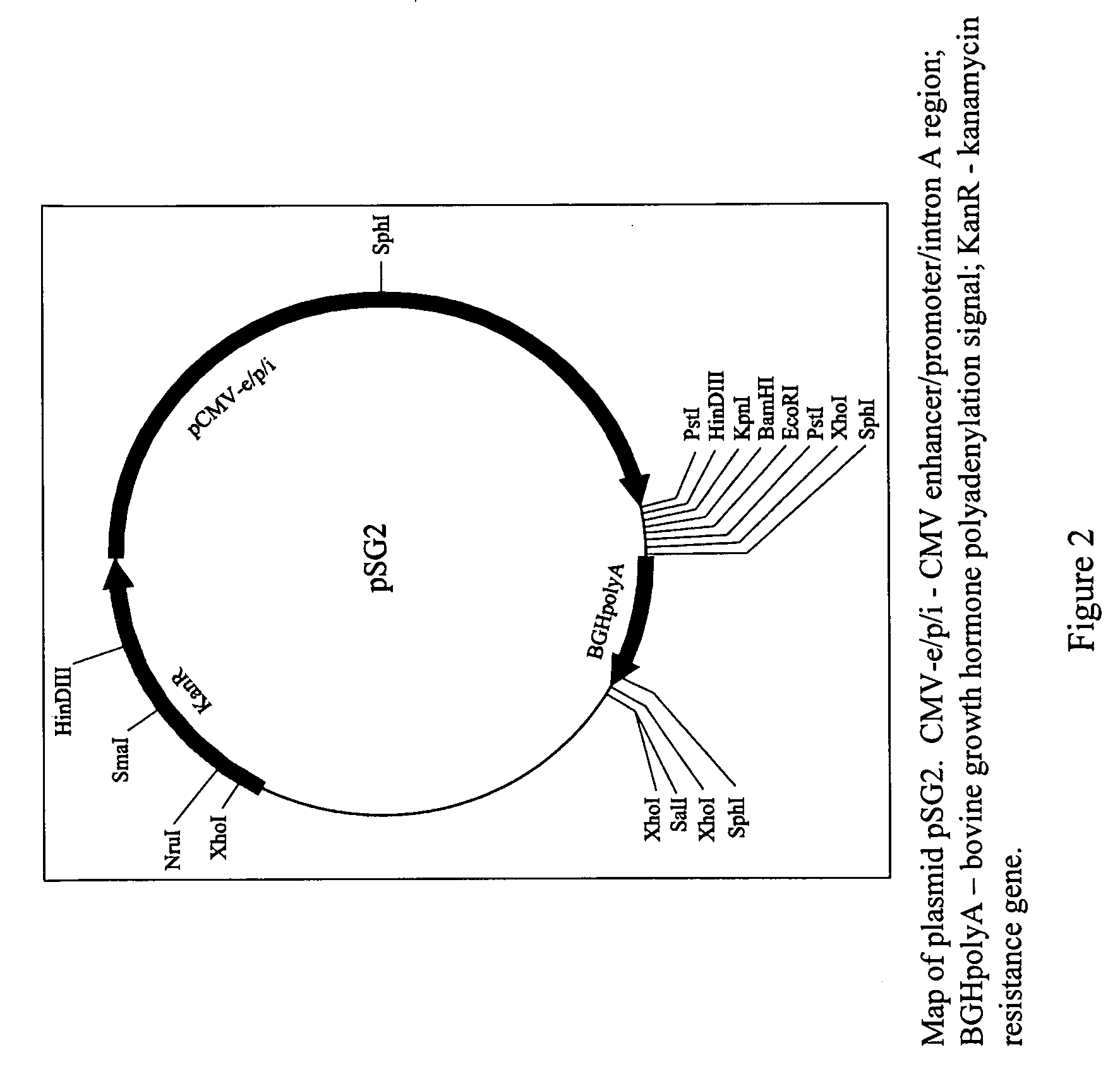Compositions for inducing an immune response against hepatitis B
a technology of immune response and composition, applied in the field of compositions for inducing an immune response against hepatitis b, can solve the problem of generating clinically effective immune responses agains
- Summary
- Abstract
- Description
- Claims
- Application Information
AI Technical Summary
Benefits of technology
Problems solved by technology
Method used
Image
Examples
example 1
Construction and Characterization of a Recombinant DNA Plasmid Expressing HBV Antigens
[0121]In order to test a prime-boost strategy for inducing an anti-HBV T-cell immune response, recombinant DNA and vaccinia virus constructs have been made containing a gene encoding the HBV surface antigen. The HBsAg gene of HBV has three potential initiation codons that divide the gene into pre-S1, pre-S2 and S regions. The small S antigen is encoded by the S region and is 226 amino acids in length. The medium S antigen is encoded by the S and pre-S2 regions and is 281 amino acids in length. This report describes the construction of a recombinant plasmid expressing the S and pre-S2 regions of HBV.
[0122]A DNA plasmid containing the S and pre-S2 regions of the HBsAg gene of
[0123]HBV was constructed and characterized.
Materials and Methods
[0124]Materials and reagents
[0125]Buffers and reagents
Buffers and Solutions:
[0126]Chemical reagents and buffers were purchased from Sigma.
Enzymes and Molecular Biol...
example 2
Construction and Characterisation of Recombinant MVA Expressing HBV Antigens
[0160]A variety of attenuated recombinant viral vectors have been developed as antigen delivery systems. However, not all attenuated viruses are replication-incompetent in mammalian hosts and the use of attenuated but replication-competent viruses can lead to side effects, particularly in immunocompromised individuals.
[0161]Modified vaccinia virus Ankara (MVA) is a strain of vaccinia virus that does not replicate in most cell types, including normal human tissues (Mayr et al 1978). MVA was derived by multiple passages of a vaccinia virus from a horse pox lesion and was administered to 120,000 people in the last stages of the smallpox eradication program in Germany. The genome of MVA has been fully sequenced and the virus has six genomic deletions totalling 30 kb. The avirulence of MVA has been ascribed in part to deletions of host range genes and it also lacks several genes coding for immunomodulatory protei...
example 3
Induction of Specific CD8+ T cell Responses Against the Hepatitis B Virus Surface Antigen in BALB / c Mice
[0230]To evaluate the ability of the pSG2.HBs and MVA.HBs immunotherapeutic to induce specific CD8+ T cell responses against the hepatitis B virus surface antigen (HBsAg), BALB / c mice were immunized intramuscularly with pSG2.HBs (50 μg) or intradermally with MVA.HBs (5×106 pfu). In BALB / c mice, the peptide IPQSLDSWWTSL (SEQ ID NO: 15) is recognized by CD8+ T cells as the immunodominant epitope. Using this peptide, CD8+ T cells were assayed using two different methods:
[0231]a cytotoxicity assay involving in vitro restimulation with peptide followed by a standard 51Cr release lysis assay;
[0232]an ELISPOT assay to determine the number of IFN-gamma secreting peptide-specific CD8+ T cells (spot forming cells=SFC).
Materials and Methods
[0233]Single cell suspensions of splenocytes were prepared as follows. Individual spleens were macerated and the suspension filtered thr...
PUM
| Property | Measurement | Unit |
|---|---|---|
| time | aaaaa | aaaaa |
| time | aaaaa | aaaaa |
| time | aaaaa | aaaaa |
Abstract
Description
Claims
Application Information
 Login to View More
Login to View More - R&D
- Intellectual Property
- Life Sciences
- Materials
- Tech Scout
- Unparalleled Data Quality
- Higher Quality Content
- 60% Fewer Hallucinations
Browse by: Latest US Patents, China's latest patents, Technical Efficacy Thesaurus, Application Domain, Technology Topic, Popular Technical Reports.
© 2025 PatSnap. All rights reserved.Legal|Privacy policy|Modern Slavery Act Transparency Statement|Sitemap|About US| Contact US: help@patsnap.com



